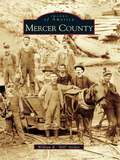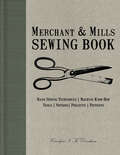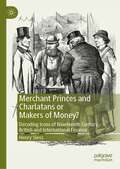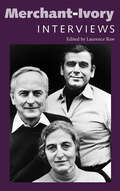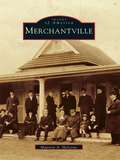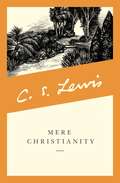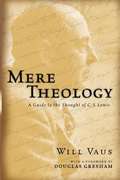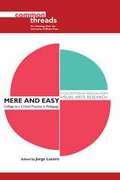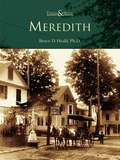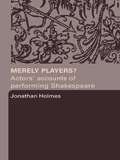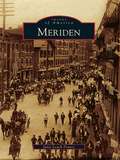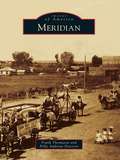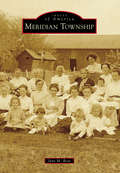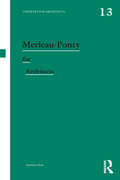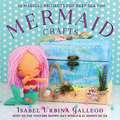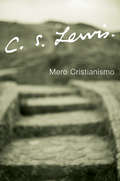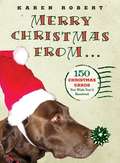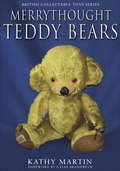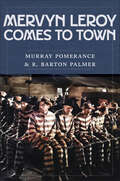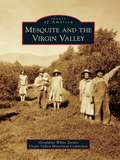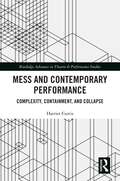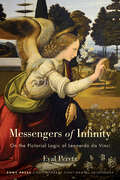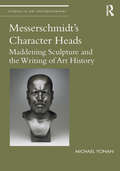- Table View
- List View
Mercer County
by William R. ArcherOriginating almost a quarter of a century prior to the Civil War, Mercer County, West Virginia was namedfor General Hugh Mercer, a Revolutionary War hero. The county has been a crossroads for many events, including the Civil War and the establishment of an industrial economy after the war ended. When two mighty railroads, the Norfolk & Western and The Virginian, began shipping coal and timber to the once-agrarian area, Mercer County blossomed into one of the five most highly populated counties of theMountain State. In 1671, colonial explorer Robert Fallam described what would become Mercer County in his journal as "a pleasing tho' dreadful sight to see the mountains and hills as if piled one upon another." Despite extreme challenges, residents ofMercer County developed a spirit of pride, independence, strength, and genuine fellowship that today makes the region a warm and friendly place to call home. As legend holds, even the notorious outlaw Frank James was so overwhelmed by the hospitality he received in Mercer County in 1882 thathe decided to pass on robbing the Bank of Princeton and, instead, robbed a bank in a neighboring county.
Merchant & Mills Sewing Book: Hand Sewing Techniques / Machine Know-How / Tools / Notions / Projects / Patterns
by Carolyn N. DenhamWith an emphasis on quality, craftsmanship, and simplicity, this beginner’s sewing guide features fifteen stylish and useful skill-building projects. The Merchant & Mills Sewing Book guides you through the basics of sewing with a series of step-by-step projects that are both functional and beautiful. Part I presents a fundamental overview on the art of sewing, the tools and materials you will need and homegrown tips on essential good practice. In Part II, seasoned dressmaker Carolyn Denham leads you through fifteen achievable projects, each building on the skills gained as you progress through the book. Crafters and aspiring designers will master hand- and machine-sewing techniques, learn about fundamental tools and materials, and improve their tailoring skills before sewing timeless projects such as a maker’s apron, bolster cushion, flight bag, classic shirt, and more. Reflecting the distinctive utilitarian style of Merchant & Mills, this book reminds readers to keep it simple and do it well.
Merchant Princes and Charlatans or Makers of Money?: Decoding Icons of Nineteenth Century British and International Finance
by Henry SlessThis book provides a critical analysis of visual images of British and international finance during the nineteenth century. Its focus is on the financiers themselves, contrasting the depiction of the respectable Merchant Princes with the less than perfect charlatans (white-collar criminals) who defrauded investors of millions. The breakdown of trust between financiers and investors that evolved during this period is represented visually in depictions of the emotional response of investors to the uncertain financial climate.Throughout the book a PEARL methodology has been used to critique the images reflecting the impact of any Publisher’s political bias, the Editorial and Artistic techniques used to convey the messages in the images, and the Legal context (especially a concern in countries such as France and Germany where censorship was strict).The book concludes that white-collar criminals were invariably secretly admired in Britain, and rarely severely satirised. Similarly, Merchant Princes were depicted favourably in Britain as members of the ruling elite during the latter half of the century. This is contrasted with the more extreme anti-monopolistic images in the US and the extreme anti-Semitic treatment of Jewish financiers in France and Germany.
Merchant-Ivory: Interviews (Conversations with Filmmakers Series)
by Laurence RawMerchant-Ivory: Interviews gathers together, for the first time, interviews made over a span of fifty years with director James Ivory (b. 1928), producer Ismail Merchant (1936–2005), and screenwriter Ruth Prawer Jhabvala (1927–2013). Beginning with their earliest work in India, and ending with James Ivory's last film, The City of Your Final Destination (2009), the book traces their career, while offering valuable insights into their creative filmmaking process. The volume serves as a corrective to the prevailing critical orthodoxy attached to Merchant-Ivory's work, which tends to regard them as being solely concerned with historically accurate costumes and settings. As independent filmmakers, they have developed an idiosyncratic approach that resists facile classification. Merchant-Ivory have insisted on maintaining their independence. More importantly, this book shows how Merchant-Ivory have always taken considerable care in casting their films, as well as treating actors with respect. This is a deliberate policy, designed to bring out one of the triumvirate's principal thematic concerns, running throughout their work—the impact of the “clash of cultures” on individuals. Partly this has been inspired by their collective experiences of living and working in different cultures. They do not offer any answers to this issue; rather they believe that their task is simply to raise awareness; to make filmgoers conscious of the importance of cultural sensitivities that assume paramount significance in any exchange, whether verbal or nonverbal.
Merchantville (Images of America)
by Maureen A. MclooneOne hundred feet above the Delaware River is Merchantville, a spirited community founded in 1874. Many wealthy Philadelphia merchants established residences while others summered in this key South Jersey center for goods and services. In 1926, the building of the Benjamin Franklin Bridge opened the door to a new era of expansion, which continues today, as Merchantville forges ahead on its prosperous path. A sign of Merchantville's past and a crowning jewel of today is the wonderful Victorian architecture seen throughout town. Many historical homes still stand, lovingly restored and maintained by enthusiastic, caring residents. Merchantville includes a look at these great homes, as well as a chronicle of the town's greatest asset, its people. Boxing champion Jersey Joe Walcott, born in 1914 in Merchantville, trained right in the center of town; Jane Eayre Fryer wrote the Mary Frances series for young girls (1911-1918); and Wallis Warfield Simpson, later the Duchess of Windsor, visited Merchantville c. 1900. But everyday life and everyday residents are what make any study of history vital, and they are what make Merchantville so outstanding.
Mere Christianity
by C. S. LewisA forceful and accessible discussion of Christian belief that has become one of the most popular introductions to Christianity and one of the most popular of Lewis's books. Uncovers common ground upon which all Christians can stand together.
Mere Theology: A Guide to the Thought of C. S. Lewis
by Will VausWhat did C. S. Lewis believe about God, Jesus Christ, the Holy Spirit, heaven, hell, creation, the Fall, the forgiveness of sins, marriage and divorce, war and peace, the church and sacraments, masculinity and femininity? Lewis was not a professional theologian, but anyone who has read his writings--whether fiction or nonfiction, essays or correspondence--knows that profoundly Christian convictions permeate them all. The more one reads, the more it becomes clear that Lewis could write with charity and simplicity while preserving theological accuracy because he was well informed and thoroughly grounded in the Christian faith. Will Vaus has masterfully brought together Lewis's thought from throughout his voluminous writings to provide us a full-orbed look into his beliefs on twenty-five Christian themes. This book gives us not only a comprehensive view of Lewis's theological convictions but also guidance and encouragement for our own spiritual journeys toward the God whom Lewis found so real, personal and present. Introduction by Douglas Gresham.
Mere and Easy: Collage as a Critical Practice in Pedagogy
by Jorge LuceroCollage making offers everyone from small children to trained artists the ability to express themselves through images. In this new Common Threads collection, Jorge Lucero draws on the archive of the journal Visual Arts Research to present articles focused on the place of collage in fine art and education. Guided by the twinned concepts of mereness --collage's reputation as a trifle--and easiness --the technique's accessibility to all--the authors explore how subversive, debased, and effortless the collage gesture can be. What emerges is in and of itself a collage, one that groups disparate scholarship into a whole that reveals how the technique may serve as a method of scholarship and as a wellspring of vibrant, even radical, pedagogical utility. Contributors: Michael Biggs, Ian Buchanan, Daniela Büchler, Paul Duncum, Charles R. Garoian, Kit Grauer, Anniina Suominen Guyas, Kathleen Keys, Jorge Lucero, Dan Nadaner, Ryan Patton, Janet N. Stevenson, Robert W. Sweeny, and Stuart Thompson.
Meredith
by Bruce D. HealdThe history of Meredith as a corporate town dates back more than two hundred thirty years. Like most older towns, especially those devoted largely to agriculture, Meredith has greatly diminished in territory since its original incorporation; unlike most New Hampshire towns of this size, however, it is progressive and prosperous, and the valuation of the town has steadily increased. This growth is the result of Meredith's change from an agricultural town to an industrial town to today's prosperous four-season resort in the heart of the Lakes Region, at the foothills of the White Mountains. Meredith, part of the Then & Now series, places vintage images alongside contemporary photographs, taken by photographer Aaron Ober, to show the changes that have taken place in this area through the years.
Merely Players?: Actors' Accounts of Performing Shakespeare
by Jonathan HolmesMerely Players? marks a groundbreaking departure in Shakespeare studies by giving direct voice to the Shakespearean performer. It draws on three centuries worth of actors' written reflections on playing Shakespeare and brings together the dual worlds of performance and academia, providing a unique resource for the student and theatre-lover alike.
Meriden
by Janis Leach FrancoIncorporated in 1806, Meriden was once proposed as the state capital. Although the plan was not implemented, the rural village quickly burgeoned into a major manufacturing center with the advent of the industrial revolution. Meriden advanced to become renowned as the "Silver City." International Silver Company and other key businesses, such as Parker Gun, Manning Bowman, Wilcox and White, and Handel Lamp, made Meriden a familiar name. Home to Gov. Abiram Chamberlain, Arctic explorer Hugh Johnson Lee, opera diva Rosa Ponselle, and baseball's Connie Mack, the city has also long been enlivened by a diverse mixture of immigrants and newcomers. Bordered on the north by dramatic traprock ridges, Meriden has a larger percentage of parklands than any other town in Connecticut, with Hubbard Park its crowning jewel.
Meridian
by Frank Thomason Polly Ambrose PetersonEight miles west of Idaho's capital city, Boise, the first settlers in what became Meridian found only arid land, sagebrush, and jackrabbits. The lone tree in the area was another 8 miles west in what became Nampa. Originally called Hunter, after a railroad superintendent, Meridian was initially a railway postal drop where workers tossed and hooked mailbags as the train passed through before the arrival of passenger service. By 1893, residents called the village Meridian, after the north-south prime meridian running through Meridian Road. In 1903, the village incorporated but still had a population of only a few hundred with grocery and harness shops and more churches than saloons. Village merchants and residents experienced orchard and dairy/creamery eras that ended in, respectively, the 1940s and 1970. Meridian became a city in the 1940s but 50 years later had a population of only 10,000. That number quadrupled over the next decade and today has nearly doubled again to around 80,000, as Meridian has evolved into the transportation and commercial hub of the Treasure Valley, especially in electronics and health care.
Meridian Township (Images of America)
by Jane M. RoseMeridian Township began as a collection of small pioneer communities. Pine Lake was the largest body of water in Ingham County, and Native tribes camped along its shores and cut a trail along the west side of the lake. White pioneers appeared in 1836 and began to turn the thick forests into viable farmland. In the late 19th century, James Haslett helped establish a community focused on the practices of spiritualism. The new Haslett Park community hosted a summer camp for believers, and the little Pine Lake community was renamed Haslett and the lake to Lake Lansing. The village of Okemos began as a settlement along the Red Cedar River, the major waterway south of Lake Lansing. The area was the seasonal campsite for Chief Okemos and his Chippewa and Ottawa followers. The community was originally named Sanford after the first white settler, renamed Hamilton after Andrew Hamilton, and finally to Okemos in honor of the old chief who died in the 1850s.
Merleau-Ponty for Architects (Thinkers for Architects)
by Jonathan HaleThe philosophy of Maurice Merleau-Ponty (1908–1961) has influenced the design work of architects as diverse as Steven Holl and Peter Zumthor, as well as informing renowned schools of architectural theory, notably those around Dalibor Vesely at Cambridge, Kenneth Frampton, David Leatherbarrow and Alberto Pérez-Gómez in North America and Juhani Pallasmaa in Finland. Merleau-Ponty suggested that the value of people’s experience of the world gained through their immediate bodily engagement with it remains greater than the value of understanding gleaned through abstract mathematical, scientific or technological systems. This book summarizes what Merleau-Ponty’s philosophy has to offer specifically for architects. It locates architectural thinking in the context of his work, placing it in relation to themes such as space, movement, materiality and creativity, introduces key texts, helps decode difficult terms and provides quick reference for further reading.
Mermaid Crafts: 25 Magical Projects for Deep Sea Fun (Creature Crafts)
by Isabel Urbina GallegoMore Enchanting Projects from the Author of Unicorn Crafts! Are you ready for an under-the-sea adventure? We’ve always been so curious about the underwater world, and this book brings us closer to the mystical universe where mermaids live with their aquatic friends, a world we could only dream of—until now! Featured here are dozens of entertaining projects, including: Treasure chestsCustom shoesMermaid jewelryPencil casesAnd much more! Whether you are just beginning, or are a pro-crafter, this book is designed to foster creativity so everyone can enjoy his or her projects. Each craft includes a list of materials, templates, detailed instructions, and plenty of colorful photos to help you out along the way. Join in on the mermaid frenzy with these unique and creative craft projects!
Mero Cristianismo
by C. S. LewisEsta obra poderosa y práctica es una de las más populares y queridas introducciones a la fe cristiana jamás escritaMero Cristianismo reúne las legendarias charlas radiofónicas de C. S. Lewis que se transmitieron durante tiempos de guerra, charlas en las cuales él se proponía "explicar y defender las creencias que han sido común a casi todos los cristianos de todos los tiempos." Rechazando los límites que dividen las distintas denominaciones del cristianismo, C. S. Lewis ofrece una inigualable oportunidad al creyente y al no creyente para escuchar un argumento fuerte y racional para la fe cristiana.Esta es una colección de la genialidad de Lewis que aún se mantiene viva para el lector moderno y que a la vez confirma su reputación como el escritor y pensador más importante de nuestros tiempos. Mero Cristianismo es su libro más popular y ha vendido millones de ejemplares a través del mundo.
Merry Christmas from . . .
by Karen Robert150 of the World's Funniest and Most Delightful Christmas Cards Karen Robert has spent the last several years tracking down the wonderful and wacky Christmas cards represented in this book-the best out of tens of thousands she has reviewed. Featuring everything from young couples in love, classic kids-'n'-dogs, and quirky workplace situations to every incarnation of Santa-fat, thin, young, old, canine-these cards will surprise you with their irrepressible creativity. Some are heartwarming, some are hilarious, some are simply strange-but every single one was actually sent out as a Christmas card. So whether you're one of the millions of people who love all things Christmas, looking for inspiration for your own holiday card, or just a desperate Scrooge on the hunt for the perfect stocking stuffer, pick up Merry Christmas from . . . for a holiday pick-me-up.
Merry Quizmas Everyone!: Christmas quizzes & games to go from the turkey to the King’s speech – have an hilarious holiday spectacular!
by Chris T MassyIt's the most hilarious time of the year...Packed full of festive pop-culture quizzes, Christmas trivia to fascinate and holly jolly games to play - as well as colouring and dot-to-dot pages to distract, and cracking cracker jokes to make you chuckle (and groan).The perfect Christmas companion for work Christmas parties, entertaining friends and family, entertaining kids (including kids), when you're too full to move, there's nothing on the TV, it's too wet for a walk and the pub isn't open yet.A book everyone will love, actually...
Merrythought Teddy Bears (British Collectable Toys Series)
by Kathy MartinA deep dive into the history of the much-loved plush bear brand from one of the world&’s foremost teddy bear experts. Merrythought was one of Britain&’s longest running British-made teddy bear firms with a dedicated international following for their quality, highly collectable bears whose life-size models used to dominate stores such as Harrods and Hamleys. This book—with its quality color illustrations and use of original sales material—will appeal to teddy bear collectors as well as dedicated Merrythought fans and is full of tips on collecting the popular toys. Written by leading teddy bear expert, Kathy Martin, editor of Teddy Bear Scene and a regular on programs such as QVC as well as a consultant to firms producing collectable bears, this is a must for collectors, dealers, and those who loved their own Merrythought teddy bears when young. After a short-term closure, Merrythought was revived and will delight future generations. Its closure made headlines news, showing the enduring popularity of the quality bears. &“This must-read book will appeal to Merrythought and teddy bear collectors and dealers, those who loved their childhood teddies and indeed anyone interested in the history of the great British toy company.&” —Collectors Club of Great Britain
Mervyn LeRoy Comes to Town
by Murray Pomerance R. Barton Palmer Tom Conley Mark Osteen Steven Rybin Dominic Lennard Rebecca Bell-Metereau Linda Badley Lawrence Napper Daniel Varndell Adrian Danks David Desser Neil Badmington Matthew Solomon Brenda Austin-Smith Matthew Cipa Kristen Hatch Matthew H. BernsteinMervyn LeRoy Comes to Town is the first book devoted to the career of one of the director/producers who in the early years of sound cinema was instrumental in establishing the Hollywood model of production that would endure for more than half a century. As a director and producer, LeRoy was responsible for turning out more than sixty feature films in a career that spanned five decades; as a studio executive, he contributed substantially to the success of the industry during the challenging period of the Depression and also in the period of realignment and readjustment that followed the end of World War II. This book offers chapters devoted to individual films such as Little Caesar, Waterloo Bridge, 30 Seconds over Tokyo, Gypsy, and Quo Vadis.
Mesquite and the Virgin Valley
by Virgin Valley Historical Committee Geraldine White ZarateThe lower Virgin River basin is located about 10 miles south of the border junction between what is now Nevada, Arizona, and Utah. Early explorers told of blistering heat, disease-carrying insects, and scarce, evil-tasting water. But in 1877, the valley offered a haven to a small group of Mormon families who sought to live and practice their religious convictions, settling in Bunkerville on the south side of the Virgin River. On the north side, the struggle to establish Mesquite started in 1880. The third attempt in 1894 was successful after years of merciless floods. Residents have survived a hostile environment, geographic isolation, political gerrymandering, and in the middle of the last century, dangerous radiation fallout from atomic testing. Deep sand roads have given way to a bustling interstate highway, and the area has become a golf and gaming destination. After incorporation in 1984, Mesquite experienced a boom and has been named the fastest growing city of its size in the United States.
Mess and Contemporary Performance: Complexity, Containment, and Collapse (Routledge Advances in Theatre & Performance Studies)
by Harriet CurtisThis book identifies and theorises mess in contemporary performance and argues that mess offers a site from which subjects might mobilise and find agency, even as the complexity (and indeed messiness) of everyday life conditions and contains.Using a queer feminist and intersectional critical framework, this book analyses how established and emerging artists mess with and mess up capitalist tendencies towards productivity, usefulness, and efficiency. Whilst the materiality of mess provides a starting point and emerges in many of the works analysed, the implications of mess as related to vulnerability, shame, and resistance occupy a larger space in the book’s chapters. These performances are messy not only in content or style; they reveal critical readings of how perceived-as messy' subjects and practices are shaped and regulated. In attending to the public, personal, and structural uses of mess, and emphasising the critical possibilities of what might otherwise be skipped over or cleared away, this book develops and opens out shared understandings of mess as creative chaos and as a practice of political action or change.This book will be of particular interest to students and scholars incontemporary theatre, art, and performance.
Messages to the World (Fountas & Pinnell LLI Gold #Level T)
by Claire Golding<p>From Hunting to Printmaking <p>When the Inuit people of Canada were forced to stop hunting for food, some started making art to earn a living. Now, a new tradition of printmaking is being passed on to the next generation of Inuit artists. <p>Text Elements <li>Genre: Expository <li>Text Structures: Main: Categorical; Embedded: Description, Cause/Effect, Chronological Sequence <li>Text Features: table of contents, headings, photos, captions, pronunciation guides, map, glossary</li></p>
Messengers of Infinity: On the Pictorial Logic of Leonardo da Vinci (SUNY series in Contemporary Continental Philosophy)
by Eyal PeretzThe first philosophical engagement with the pictorial work of Leonardo, seen as a systematic whole.Presented here is the first philosophical engagement with the pictorial work of Leonardo, seen as a systematic whole. It is not written from the point of view of an art historian, even as it tries to benefit from art historical insights and procedures, but that of contemporary continental philosophy and theories of modern artistic media. Author Eyal Peretz's main objective is to understand the historical and logical place Leonardo's paintings occupy in the transition from the age of medieval sacred images to Renaissance or early modern painting. Leonardo, Peretz argues, introduced a media revolution, which has still not been fully assimilated and understood. His "modernity" is still ahead of us. Written in a clear and engaging style, Messengers of Infinity, will appeal equally to Leonardo experts, experts in continental philosophy, and those who are experts in neither of these fields but have an intellectual curiosity about the historical and conceptual significance of Leonardo in particular and of modern painting in general.
Messerschmidt's Character Heads: Maddening Sculpture and the Writing of Art History (Studies in Art Historiography)
by Michael YonanThis book examines a famous series of sculptures by the German artist Franz Xaver Messerschmidt (1736–1783) known as his "Character Heads." These are busts of human heads, highly unconventional for their time, representing strange, often inexplicable facial expressions. Scholars have struggled to explain these works of art. Some have said that Messerschmidt was insane, while others suggested that he tried to illustrate some sort of intellectual system. Michael Yonan argues that these sculptures are simultaneously explorations of art’s power and also critiques of the aesthetic limits that would be placed on that power.
